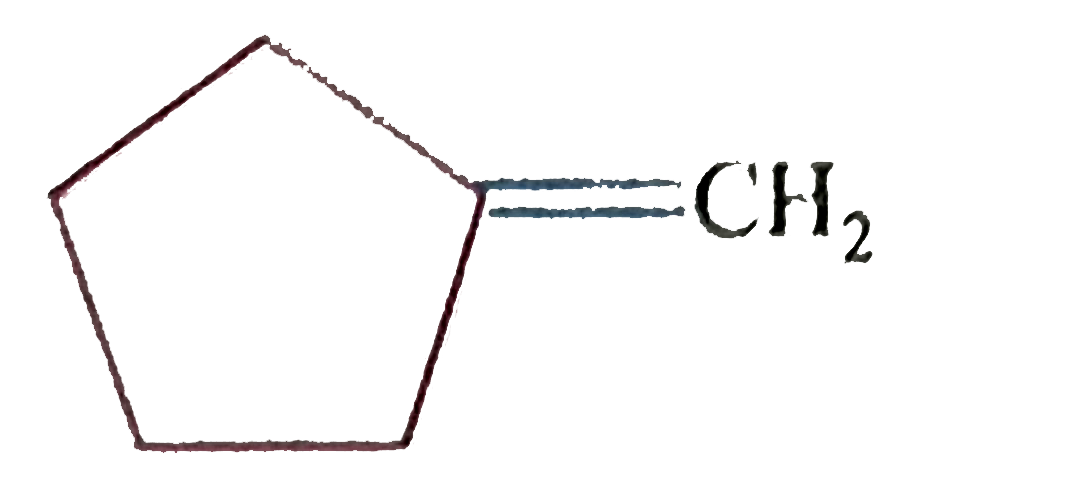Ozonolysis of o-xylene (1,2-dimethylbenzene) gives_____different products.
two
four
three
just one
The correct Answer is:C
To determine how many different products are formed from the ozonolysis of o-xylene (1,2-dimethylbenzene), we can follow these steps:
Step 1: Understand the structure of o-xylene
o-Xylene has the following structure:
- It is a benzene ring with two methyl groups (-CH3) attached to the 1 and 2 positions (ortho position).
Step 2: Identify the double bonds in o-xylene
- In the case of o-xylene, we can consider the presence of double bonds in the aromatic ring. However, for ozonolysis, we focus on the double bonds that can be formed during the reaction.
Step 3: Perform ozonolysis
- Ozonolysis involves the cleavage of double bonds in the presence of ozone (O3). In the case of o-xylene, we can visualize the reaction leading to the formation of carbonyl compounds.
Step 4: Analyze the products formed
1. When the double bond between the two carbons in the benzene ring is cleaved, we can form:
- Two products:
- One product will have a carbonyl group (C=O) and a methyl group (CH3).
- The other product will also have a carbonyl group and a methyl group.
2. Additionally, we can have:
- Another product formed from the cleavage of the remaining double bond, leading to:
- A product with a carbonyl group and a hydroxyl group (aldehyde).
Step 5: Count the distinct products
- From the analysis, we can summarize the products:
1. Acetophenone (C6H5COCH3) - from one of the methyl groups.
2. Benzaldehyde (C6H5CHO) - from the other methyl group.
3. Glycol (C2H4O2) - resulting from the cleavage of the double bond.
Conclusion
- Therefore, the ozonolysis of o-xylene gives 3 different products.
Final Answer
The answer is 3 different products.
---
o-Xylene has the following structure:
- It is a benzene ring with two methyl groups (-CH3) attached to the 1 and 2 positions (ortho position).
Step 2: Identify the double bonds in o-xylene
- In the case of o-xylene, we can consider the presence of double bonds in the aromatic ring. However, for ozonolysis, we focus on the double bonds that can be formed during the reaction.
- Ozonolysis involves the cleavage of double bonds in the presence of ozone (O3). In the case of o-xylene, we can visualize the reaction leading to the formation of carbonyl compounds.
1. When the double bond between the two carbons in the benzene ring is cleaved, we can form:
- Two products:
- One product will have a carbonyl group (C=O) and a methyl group (CH3).
- The other product will also have a carbonyl group and a methyl group.
- Another product formed from the cleavage of the remaining double bond, leading to:
- A product with a carbonyl group and a hydroxyl group (aldehyde).
- From the analysis, we can summarize the products:
1. Acetophenone (C6H5COCH3) - from one of the methyl groups.
2. Benzaldehyde (C6H5CHO) - from the other methyl group.
3. Glycol (C2H4O2) - resulting from the cleavage of the double bond.
- Therefore, the ozonolysis of o-xylene gives 3 different products.
The answer is 3 different products.
Topper's Solved these Questions
- BOOK - R SHARMACHAPTER - AROMATIC HYDROCARBONSEXERCISE - Archives59videos
AROMATIC HYDROCARBONS
- BOOK - R SHARMACHAPTER - AROMATIC HYDROCARBONSEXERCISE - Follow up Test 77videos
AROMATIC HYDROCARBONS
- BOOK - R SHARMACHAPTER - ALKYNESEXERCISE - Archives42videos
ALKYNES
- BOOK - R SHARMACHAPTER - CHEMICAL BONDINGEXERCISE - Archives73videos
CHEMICAL BONDING
Similar Questions
Knowledge Check
- Question 1 - Select One
Ozonolysis of p-xylene gives
AGlyoxalBMethyl glyoxalCBoth of theseDNone of these - Question 2 - Select One
Ozonolysis of propene gives
APropan-2-oneBEthanal and MethanalCMethanalDNone of these - Question 3 - Select One
Ozonolysis of mesitylene gives
AH3C−O∣∣C−CHOBH−O∣∣C−O∣∣C−HCCH3−O∣∣C−O∣∣C−CH3DC6H5COCHO


